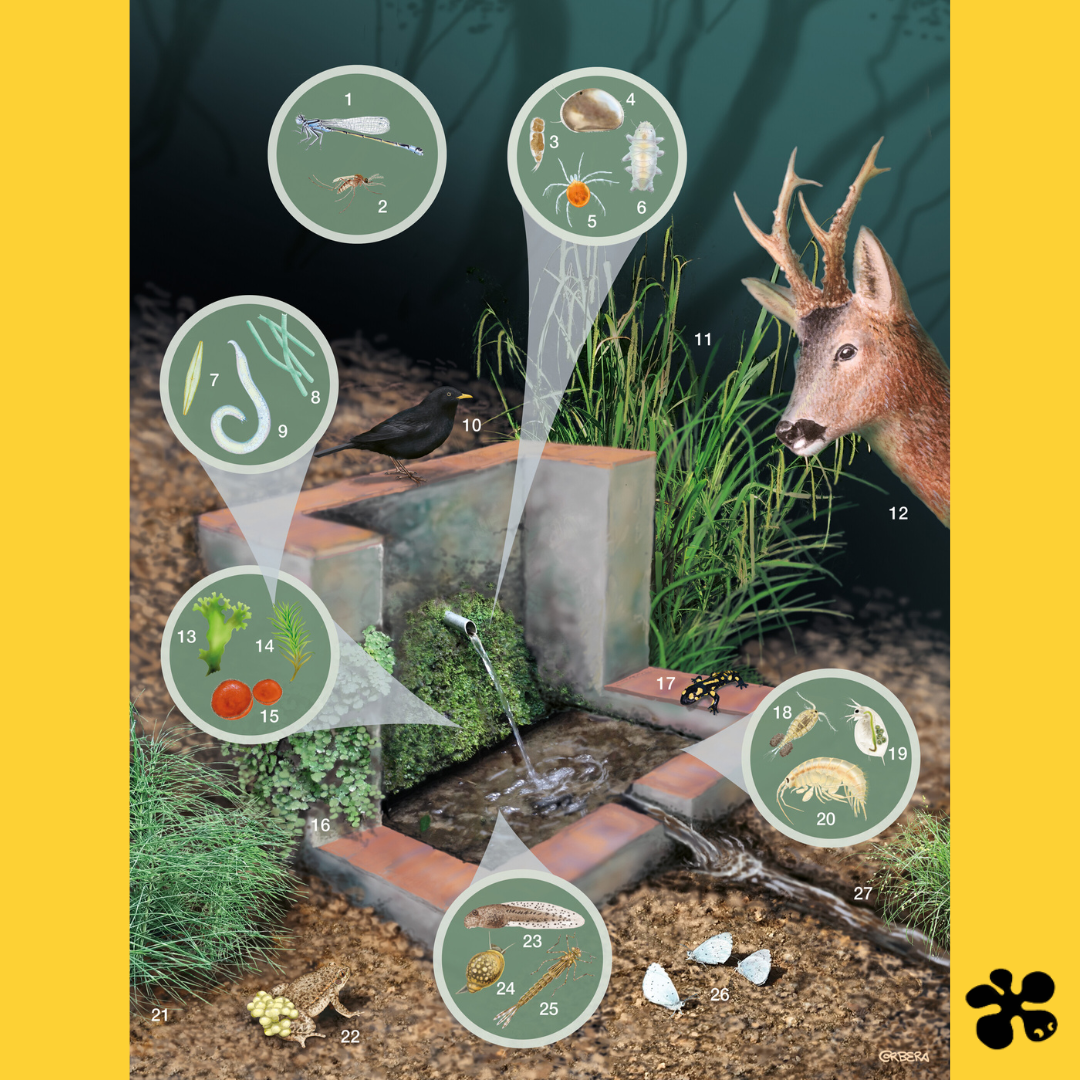Sources from regions with a Mediterranean climate are threatened by global change
The fountain ecosystems of regions with a Mediterranean climate have great biological diversity, including many species of invertebrates and plants exclusive to some sources. However, changes in temperature, precipitation and land use patterns are seriously affecting the ecological integrity of these aquatic ecosystems. This is one of the main conclusions of the study led by the Center for Ecological Research and Forest Applications (CREAF) of Catalonia and in which professor and researcher Núria Bonada, from the research team FEHM-Lab (Freshwater Ecology, Hydrology and Management) of the Biodiversity Research Institute, IRBio, of the University of Barcelona participated along with 15 other scientific institutions from Spain, Portugal, Italy and Switzerland.
According to the research team, regions with a Mediterranean climate are among the most threatened ecosystems in the world, due to the reduction of water resources and the intense impacts derived from human activity. These regions exhibit arid or semi-arid conditions and generally include the Mediterranean basin, California (USA), central Chile, the Western Cape region (South Africa), and southwestern Australia. Given their arid conditions (annual precipitation less than 500 mm), the sources - or fountain ecosystems - of these regions host an extraordinary biodiversity of animals and plants, although to date no study had highlighted their high ecological interest or their vulnerability to global change.
The study, published in the journal Global Change Biology, evaluates the factors of hydrogeological, climatic, biological and human origin that determine the functioning of Mediterranean sources, as well as the main threats that loom over these aquatic ecosystems. To do this, a multidisciplinary team of 17 specialists in ecology, limnology, hydrogeology, botany, zoology and conservation biology compiled the information available in the published scientific literature for a synthesis of the main characteristics of the sources. In addition, the researchers used data on sources located in the coastal mountains of Catalonia as a case study to highlight the impact of global change on the preservation of these ecosystems.
The sources constitute discharge points of an aquifer in an eminently terrestrial landscape and, generally, appear more frequently in mountainous areas with steep topography. Hydrogeology determines the chemical composition of water, whose load in cations and anions is related to the type of rock in the aquifer and the residence and transit time of the water. Despite their small dimensions, the fountains present a multitude of different microenvironments that form a mosaic and allow the coexistence of a wide range of life forms. There are species of invertebrates that develop in the water upwelling where sunlight does not reach, while others prefer to live in the central basin, or in the humid environment, which marks the limit between the aquatic and terrestrial environments.
The sources of Mediterranean regions appear dispersed in the landscape and isolated from each other, giving the animal and plant species associated with these ecosystems few options to colonize new environments. This attribute has caused Mediterranean sources to present a high number of endemic species (exclusive to one or a few sources). For example, up to 18 species of water mites (Hydrachnnida) have been described as endemic to Italian sources, while another 18 species of molluscs are endemic to Australian sources of the Lake Eyre basin. An extreme example of the extraordinary number of endemisms that some spring ecosystems support can be found in the Great Artesian Basin (Australia), where 51 species of molluscs, 24 of crustaceans and eight of fish have been described that are endemic to springs located in this region. . The limited information available on flora associated with sources also suggests that these ecosystems maintain a rich plant community, including numerous species of diatoms (microscopic algae) and endemic mosses.
Despite their high ecological value, Mediterranean sources face a wide range of threats derived from human activity, among which are the reduction in the availability of water resources, the overexploitation of aquifers, organic and inorganic pollution. (urban discharges and agricultural leaks) and by emerging waste (microplastics and synthetic products), the introduction of exotic species and the abandonment of traditional practices.
As a case study, the work quantifies a 92% reduction in the flow of 31 sources monitored between 2013 and 2023 in the coastal mountains of Catalonia, with 45% of these sources having dried up in just one decade. The authors conclude the work with recommendations for coordinated strategies that guarantee the effective conservation of these threatened ecosystems and demand the urgent preservation of the sources under the designation of a specific protection figure.
This collaborative study is the result of work sessions held in Mataró in mid-February 2023 and organized by CREAF within the framework of the Severo Ochoa Scientific Excellence recognition. At the conference, all the authors of the work met to share the knowledge gathered in different fields related to fountain ecosystems and establish a roadmap for the development of the study.
Access to the article: Fernández-Martínez, M., Barquín, J., Bonada, N., Cantonati, M., Churro, C., Corbera, J., Delgado, C., Dulsat-Masvidal, M., García, G., Margalef, O., Pascual, R., Peñuelas, J., Preece, C., Sabater, F., Seiler, H., Zamora-Marín, J.M. & Romero, E. 2024. Mediterranean springs: Keystone ecosystems and biodiversity refugia threatened by global change. Global Change Biology, 30(1):e16997. https://doi.org/10.1111/gcb.16997
Fuente: Universitas Miguel Hernández, press release done by Servicio de Comunicación, Marketing y Atención al Estudiantado.
